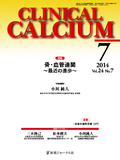Japanese
English
- 有料閲覧
- Abstract 文献概要
- 1ページ目 Look Inside
- 参考文献 Reference
糖尿病や動脈硬化といった生活習慣病罹患例では,動脈硬化に伴う心血管イベントが生命予後を脅かす。このため,動脈硬化の病態解明や病勢評価のためのサロゲートマーカーや治療薬の開発は目覚ましいものがある。これに対し,骨粗鬆症は骨折リスクが高まる全身性の疾患で,生活の質(QOL)の低下や健康寿命の短縮に影響を及ぼす運動器疾患と考えられてきた。このため生命予後にかかわる生活習慣病に比べて,その対策は遅れている。しかし,近年,骨粗鬆症性の椎体骨折や大腿骨近位部骨折は生命予後を悪化させることが明らかにされている。いわゆるメタボリックシンドロームと,運動器の障害であるロコモティブシンドロームとは別の次元の疾患概念なのだろうか。近年の研究から動脈硬化を誘導する因子,酸化ストレスが,骨の単位体積あたり50%を占めるコラーゲンの翻訳後修飾に異常をもたらし骨折リスクを高めることが明らかとなってきた。
It has become clear that a reduction in sex hormones from middle age onwards, increasing age, and an increase in oxidative stress related to lifestyle-related diseases can also reduce bone material properties in terms of collagen post-translational modification, crosslink formation. These changes lead to both qualitative and quantitative abnormalities in collagen, which is the major bone matrix protein. The intermolecular cross-link formation of collagen, which regulates bone-material attributes, is a mechanism independent of bone remodeling. In other words, cross-link formation is controlled by the environment surrounding the bone matrix, comprising cellular functions, oxidative stress, and glycation level. Because oxidative stress is also risk factor of arteriosclerosis and cardiovascular event, there is link between low bone quality and arteriosclerosis. High levels of pentosidine in urine or blood, or mild hyperhomocysteinemia which suggest bone collagen abnormalities, might be used as surrogate markers for evaluating bone quality, assessing the risk of bone fracture. Patients with osteoporosis can be divided into 3 types on the basis of bone density and with bone quality. We are entering an age in which the treatment of osteoporosis will be personalized, with drugs administered depending on these types.



